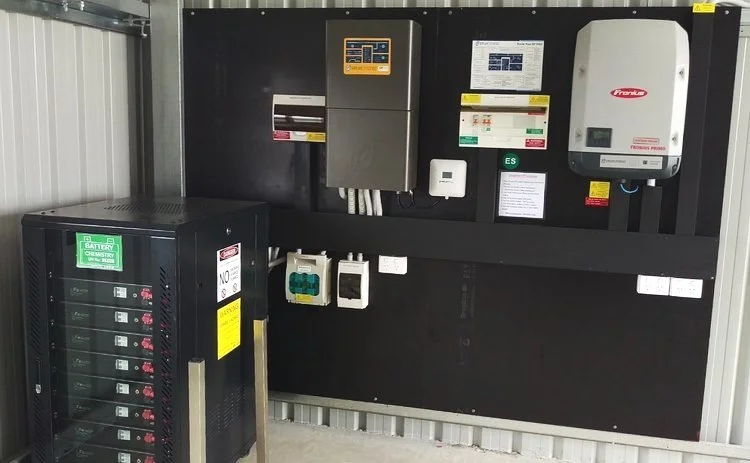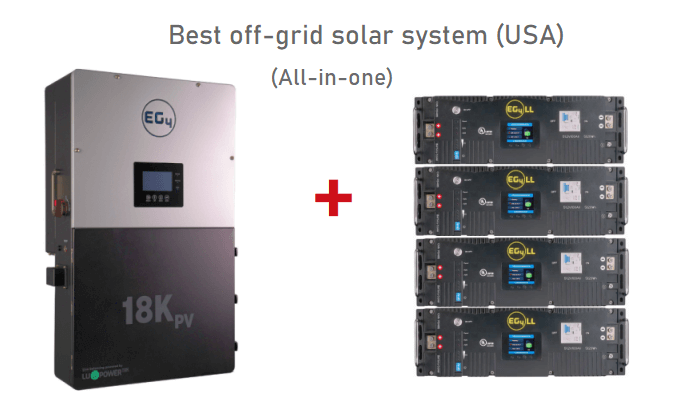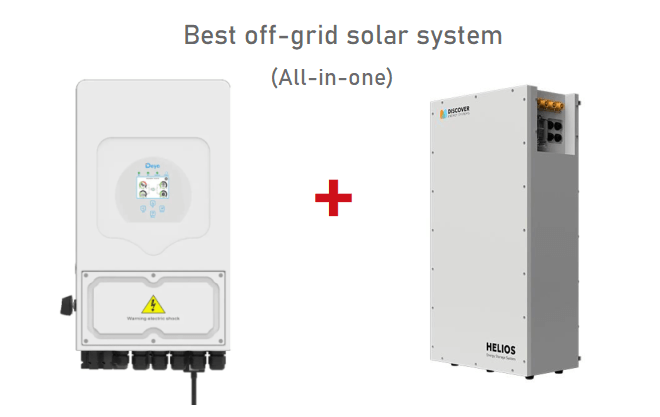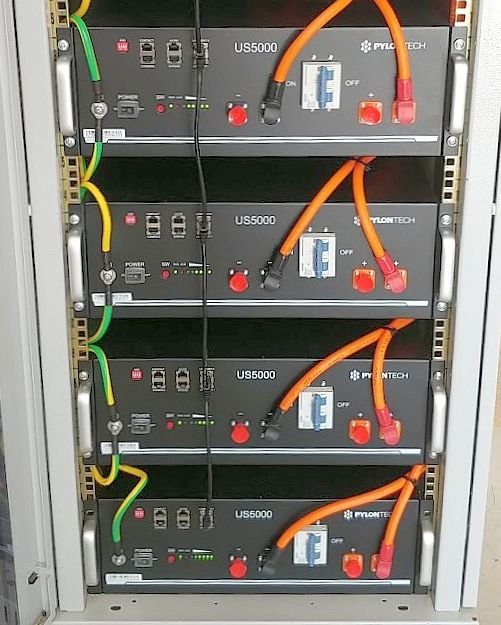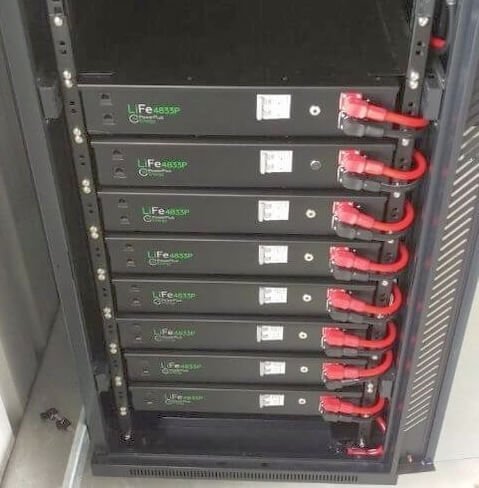Best off-grid solar systems
How to choose an off-grid solar system for your home
Choosing an off-grid solar power system for your home is not easy, as off-grid systems are far more complicated than standard grid-connected solar systems. This article highlights the important factors that must be considered and describes the various off-grid systems available. We also explain why a good quality off-grid inverter is vital to building a reliable system. Finally, we will dive into the available batteries and determine which systems best suit different applications.
Many people believe off-grid solar systems can be easily put together. This may be true in the case of a small caravan or cabin, but larger off-grid systems used to power homes and businesses can cost tens of thousands of dollars and be problematic if designed incorrectly. This is why off-grid systems should be carefully sized and designed by an experienced off-grid professional, taking into account the household loads, maximum demand, solar irradiance, and system losses.
The five main parts of an off-grid system
Unlike standard grid-connected solar systems, which generally consist of solar panels and a regular grid-tie inverter, off-grid systems are more complex, requiring more equipment, including batteries, off-grid inverters, solar charge controllers, AC-coupled inverters, and backup generators.
Solar panels
Off-grid Inverter-charger
Solar inverter or Solar charge controllers
Battery bank
Generator (Optional)
Basic diagram of a AC-coupled off-grid system - Well suited for modern off-grid homes and businesses with high daytime AC loads
Recommended Off-Grid Solar Systems
The following five systems represent the top-performing off-grid solar systems available across different regions. While most off-grid systems allow for the interchangeability of many components, it's crucial to note that not all inverters, MPPTs, and batteries are compatible. As explained below, DC-coupled off-grid systems, such as those from Victron and Selectronic, are the most reliable and scalable options. This is due to the fact that the solar array size of DC-coupled systems using multiple (external) MPPTs is technically unlimited, unlike AC-coupled solar inverters, or all-in-one (hybrid) inverters, which are limited to the max allowable PV sizing per inverter. Additionally, systems using DC-coupled MPPT charge controllers will not shut down if one of the MPPTs is disabled or fails.
That being said, the most flexible and secure systems are those that utilise both AC and DC-coupled solar; this also applies to all-in-one inverter systems, such as those from EG4 and Deye, which can operate with multiple inverters in parallel.
1. Best modular off-grid solar system
Small to medium-sized homes * (Available Internationally)
Off-grid Inverter: Victron Multiplus II 8000 6.5kW Inverter. (larger 10 or 15kVA models available)
Charge Controller: One or more Victron MPPT solar charger controllers (models up to 200A)
Battery System: Pylontech US5000 Lithium LFP rack-mount battery (modular and Scalable)
Backup Power: Auto-start diesel generator 8 to 10kVA
2. Best AC-coupled off-grid solar system
Medium-sized homes * (Available in Australia)
Off-grid Inverter: Selectronic SP PRO SPMC482 (7.5kW) Inverter
Solar Controller: Fronius Solar Inverter & AERL MPPT charge controllers
Battery System: PowerPlus Energy ECO or Premium Battery System (modular and Scalable)
Backup Power: Auto-start diesel generator 10 to 12kVA
3. Best off-grid DC-coupled system (USA)
Medium-size homes * (Available in the USA)
Off-grid Inverter: Outback Power Radian GS8048 (8kVA) Inverter
Charge Controller: Outback MPPT solar charge controllers
Battery System: Discover AES Rack-mount Battery (5.12kWh modules)
Backup Power: Auto-start diesel/propane generator 12kVA
4. Best all-in-one inverter off-grid system (USA)
Medium-size homes * (Available in the USA)
All-in-one Inverter: EG4 18kPV (12kW) Multi-mode Inverter
Battery System: EG4 LL-S Rack-mount battery system (5.12kWh modules)
Backup Power: Auto-start diesel/propane generator 12kVA
5. Best Value all-in-one inverter system
Small to Medium-size homes * (Available internationally)
All-in-one Inverter: Deye Sun 8K (8kW) Multi-mode Inverter (larger 10 to 16kW models also available)
Battery System: Discover HELIOS ESS 16kWh battery (modular capability)
Backup Power: Auto-start diesel/propane generator 8kVA
The systems featured above are among the most popular and have a proven track record of reliability, based on many years of use and low failure rates. However, there are other reputable off-grid inverters and battery options available on the market. Before making any off-grid equipment purchases, we advise reading this article along with our related articles about designing off-grid solar systems. Additionally, we strongly recommend engaging an experienced professional for the design and installation of off-grid systems.
(*) This is a basic guide only. The selection and sizing of off-grid inverters and equipment must be done based on the household's average and peak energy demands (load calculations).
Off-grid System Types Explained
Off-grid systems are generally built using either AC or DC-coupled power sources. AC-coupled generation sources include common solar inverters and backup generators (gen-sets), while DC-coupled sources include solar charge controllers (MPPTs) or micro-hydro systems. Some modern systems use simpler all-in-one hybrid inverters that integrate a battery inverter and solar inverter into one compact unit.
AC or DC-coupled solar
Whether a system is AC or DC-coupled is generally based on the size of the system. Most small-scale systems are DC-coupled and use low-cost, efficient MPPT solar charge controllers. Larger off-grid systems used for homes can be AC or DC-coupled, depending on the type of off-grid inverter used and compatibility with different solar inverters.
Most modern off-grid inverters can be both AC and DC-coupled, creating a very secure, flexible power system with multiple charging options. DC-coupling can provide black-start functionality, which enables easier system restart if the main inverter shuts down, the backup generator fails, or the batteries are fully depleted.
Basic layout of a DC-coupled off-grid system - The most versatile and modular off-grid configuration
Small-scale DIY off-grid solar systems
Most small-scale off-grid solar systems and DIY systems used on caravans, boats, small homes, and cabins use MPPT solar charge controllers, also known as solar regulators, which are connected between the solar panel (s) and battery. The job of the charge controller is to ensure the battery is charged correctly and, more importantly, not overcharged. Most small 12V/24V solar charge controllers also have load output terminals, which are often used for simple DC lighting circuits. In small DIY systems, simple ‘plug-in-socket’ style inverters provide 240V or 120V AC power. These are available in many different sizes, from tiny 150W inverters up to 2000W or higher.
Note: Small-scale, low-voltage systems can still cause damage or serious injury if not installed correctly - we recommend a trained, licensed solar or electrical professional installs all systems.
MPPT & PWM Solar charge controllers
Solar charge controllers have been around for decades and are available in two main types: PWM and MPPT. Learn more about solar charge controllers and how to size small-scale off-grid solar systems correctly. More powerful MPPT Solar charge controllers up to 200A are used on larger-scale off-grid solar power systems. These are a very efficient and reliable way of charging and managing high-capacity lithium or lead-acid battery systems.
Best Off-Grid Battery Options
Over the last few years, lithium batteries, particularly LFP (lithium Ferro Phosphate) systems, have become extremely popular due to their high round-trip efficiency (92% to 98%), compact size, lightweight, and scalability. In contrast, most lead-acid battery banks are bigger, heavier, have much lower round-trip efficiency (75 to 80%), and have a fixed capacity due to the battery cells (2V) being connected in series. On the other hand, most lithium systems are comprised of individual (24V or 48V) battery modules connected in parallel, so they do not suffer the same limitation. This flexible sizing allows additional battery capacity to be added at a later stage, as each lithium battery can operate independently and is generally not affected by the older batteries. This modular feature is a real bonus for both installers and customers alike, especially as household loads and demands can change over time.
Another significant advantage of lithium batteries is their ability to maintain a low (or partial) state of charge for an extended period without experiencing negative effects, such as sulfation, a common issue with lead-acid batteries. Also, much higher charge rates can be achieved using lithium, with charging times up to 70% faster than lead-acid batteries. See our complete solar battery review for a detailed comparison of lithium batteries from the leading manufacturers.
The recommended self-managed lithium (Lithium Ferro Phosphate) batteries from the leading battery manufacturers include Simpliphi, GenZ, Discover AES, PowerPlus Energy and Zenaji Aeon.
Types of Lithium-Ion Batteries
Lithium batteries have a much higher energy density than lead-acid batteries and are, therefore, lighter and more compact. They also contain an integrated battery management system, or BMS, which regulates the charge current and voltage, protects the battery from over- or under-voltage, and monitors the internal cell temperatures. However, there is not just one single type of lithium battery. Below are the 3 most common types of lithium battery chemistries.
LFP Lithium Batteries
The most popular type of lithium battery chemistry used today is Lithium-ferro-phosphate, commonly referred to as Lithium-Iron, LFP or LiFePO4. These batteries have proven to be more thermally stable and much safer compared to other types of lithium batteries due to their high ignition point and the fact that they do not generate flammable gases when overheated or damaged. LFP also has a longer lifespan than most other Lithium batteries. Learn more about LFP battery lifespan and how to prolong the life of LFP batteries.
NMC Lithium Batteries
The second most popular lithium chemistry used for storage batteries is Nickel-Manganese-Cobalt Oxide batteries, also known as NMC batteries and often mistakenly referred to as Lithium-ion (all lithium batteries are technically lithium-ion). These batteries are used in the Tesla Powerwall 2 and can be charged and discharged at a higher rate compared to LFP without reducing battery life. However, lithium NMC is not as thermally stable and requires a more controlled environment, which is why the Powerwall 2 battery features a sophisticated liquid thermal management system.
LTO Lithium Batteries
A third, lesser-known type of lithium chemistry is Lithium Titanate or LTO. These batteries are claimed to have the longest cycle life (10,000+ cycles) and a lifespan of over 20 years, and can be safely charged and discharged at extremely high rates. However, LTO batteries are very expensive and, due to the large voltage fluctuations, are not compatible with some off-grid inverters, which cannot accommodate the extreme voltage variations.
Advantages of Lithium Batteries
Very high round-trip efficiency - 92% to 98%
Very high energy density - Compact and Lightweight
High charge and discharge rates allowed
No degradation issues with a partial state of charge
Modular and scalable systems (upgradable)
Safe and low risk (if charged correctly), in particular LFP cells.
Most lithium batteries come with a 10-year warranty
Disadvantages of Lithium Batteries
Increased degradation at high temperatures (45+ deg C)
Can not charge at low temperatures (generally below 5 deg C)
The BMS can ‘trip off’ due to high surge load spikes.
It is more difficult to recycle at the end of the battery's life.
Requires a compatible hybrid or off-grid inverter (managed batteries).
Off-grid Lithium Battery Systems
Managed lithium batteries
The popular Pylontech US5000 (LFP) modular rack mount battery system.
Managed lithium battery systems contain a BMS (Battery Management System) and require a dedicated communication link to the inverter. If the inverter isn’t compatible with the battery, they cannot function together and will not work. While generally very reliable, one potential issue with this type of system is that if communication is lost or suffers interference, the inverter or battery may shut down to prevent overcharging or discharge of the battery. However, managed batteries offer the advantage of individual module-level monitoring, which is useful if one or more of the modules are underperforming or faulty. They also provide very precise battery level data and accurate SOC at all times.
In Australia and much of Asia, the Pylontech US series and BYD LVL Premium series are popular managed lithium batteries used for grid-connected or off-grid systems, as they are compatible with a wide range of hybrid and off-grid inverters, including SMA, Selectronic, and Victron. In the US and North America, RUIXU and EG4 server mount (rack-mount) batteries are proving to be extremely popular due to competitive pricing and local support.
See the complete off-grid lithium battery chart here.
Self-managed lithium batteries
A 26.4kWh self-managed lithium LFP battery system from PowerPlus Energy. Each 3.3kWh module operates independently.
There are several self-managed lithium battery options available that also contain a BMS but do not require a communication connection (such as CANbus) with the inverter in order to operate. Most self-managed batteries are modular and able to be scaled to create very large capacity battery banks. Much like managed batteries, the internal BMS is used to monitor the state of charge (SOC), temperature and cell voltages. Another advantage of this type of battery system is that it can be easily retrofitted to replace old lead-acid battery banks, as it does not require any special communications or connections, much like lead-acid batteries. In the event of a system shutdown or system black due to a low state of charge or low voltage, most self-managed batteries will restart automatically and do not require manual activation or reset to restart operation.
One disadvantage of self-managed battery systems is that the battery state of charge (SOC) must be monitored via an (external) DC shunt (current meter), which requires precise programming and calibration to ensure the SOC value is accurate according to the battery specifications. This generally works very well; however, if the shunt is not installed or programmed correctly, accelerated battery degradation can occur, resulting in low-voltage shutdown events and even premature battery failure.
Off-grid Inverter Options
Off-grid inverters used to power modern off-grid homes are powerful battery inverters capable of supplying pure sine wave AC power to all loads and appliances under all conditions. These inverters also contain powerful built-in chargers, which is why they are often referred to as inverter chargers. Off-grid inverters are available in a wide range of sizes from 2.4kW up to 20kW and generally contain large, heavy transformers that can power appliances with high-surge loads, including pumps, compressors and other air-conditioning units.
Modern off-grid inverters, often referred to as multi-mode inverters due to their ability to operate in various modes, are the heart and brain of any off-grid system. These sophisticated inverters, including Victron Multplus, Selectronic SP-PRO, Outback Power, Schneider XW+, and SMA Sunny Island, are capable of managing multiple power sources simultaneously, such as AC or DC-coupled backup generators, and can even be grid-tied, operating in hybrid mode. Off-grid inverters must be sized correctly according to the loads and appliances they will be running. Many cheap (online) battery inverters cannot handle high continuous or surge loads, which can lead to system failure or frequent tripping events. See our best off-grid inverter review for the highest quality and best-performing off-grid inverters.
Selecting an Off-Grid Inverter
For a detailed guide to selecting and sizing an off-grid inverter, see our Technical Guide to Choosing Off-Grid and Energy Storage Systems. An experienced solar professional should provide a load table to help determine which type and size inverter will best suit your needs. A load table or a load calculator is also required to help accurately size the solar array, battery and backup generator.
How much do off-grid solar systems cost?
The cost of an off-grid home system can vary substantially based on factors such as system size and complexity. For example, an off-grid setup designed to power a small home or cabin with essential appliances and lighting typically starts from as little as $12,000, but could reach $30,000 including installation (excluding a backup generator), including 6 to 9 kW of solar panels, batteries and enclosure, solar charge controllers, and a smaller-capacity 4 to 5 kW off-grid inverter. Mid-sized systems capable of powering efficient homes with modern appliances and electric heating and cooling generally fall within the $30,000 to $60,000 range. These systems incorporate higher-capacity batteries, more powerful inverters, and larger 10- to 15-kW solar arrays. For off-grid systems supporting larger homes or multiple buildings, costs can exceed $60,000 and may extend into the six-figure range.
Small home or Cabin: $15,000 to $28,000 - 6 to 9kW Solar array, 10kWh battery & 5kW Inverter (*)
Average home: $26,000 to $60,000 - 8 to 15kW Solar array, min 20kWh battery & 8kW Inverter (*)
Large home or business: $50,000 to $90,000+ - 20kW+ Solar array, 40kWh battery & 10kW Inverter (*)
(*) Several factors can significantly impact the system size and cost, with the primary factor being the household's daily energy usage, particularly during winter. The higher the energy usage, the more solar and batteries will be required, along with a larger inverter.
Other factors include whether the solar array is roof-mounted or ground-mounted, the type of roof, the inverter & battery location (exposed to weather or rain), and the distance from the solar array to the inverter. Underground cabling (if required) can also significantly increase costs and complexity.
What you should know before selecting an off-grid solar system
Off-grid systems must be sized accurately to meet the household's average and peak energy demands throughout the year, as well as during adverse weather conditions. If the various seasonal loads and loss factors are not taken into account during the initial design process, this often results in an undersized system, leading to poor performance, frequent power loss and even system failure. Learn more in our detailed guide to designing off-grid solar systems.
Key considerations when sizing an off-grid solar system:
Daily energy consumption (kWh) - Summer and winter daily loads - using an off-grid calculator.
Peak loads (kW) - The maximum peak (surge) power demand (startup LRA).
Maximum demand (kW) - Inverter maximum continuous load (30-minute rating).
Battery capacity and power rating - Ensuring the battery can sustain the peak and surge loads.
Solar Sizing and local irradiance - Location, Climate, Panel Orientation, and Shading Issues.
Backup power options - A Generator for periods of poor weather or faults.
With the above considerations in mind, a critical component of an off-grid power system is the primary inverter, often referred to as an inverter-charger. They are not just inverters, but also battery chargers, and must be able to meet peak surge loads, maximum demand, and adequately charge the battery via AC-coupled solar or a backup generator. Learn more about the best off-grid inverters in our detailed review.
Important Considerations when going off-grid
Every off-grid solar system differs due to individual household energy requirements, local climate and weather. System performance can vary significantly based on geographical location (sunlight availability), potential shading (particularly in winter), building efficiency, consumption patterns (including summer and winter loads), and the need for large backup generators or load monitoring.
Talk to a professional
While the initial investment may seem significant, correctly designed and sized off-grid solar systems, using quality equipment, will supply reliable power for many years and offer long-term savings by reducing backup generator runtime and maintenance costs. It's crucial for homeowners to conduct a detailed assessment, using a load calculator in conjunction with a solar professional, to determine the most suitable system size and features based on individual needs and budget constraints.

